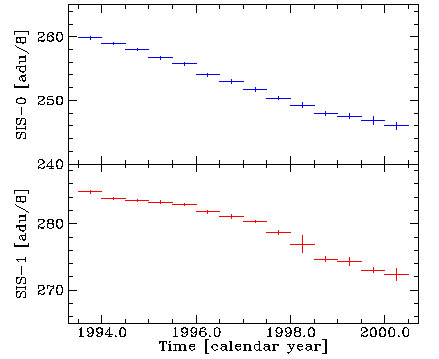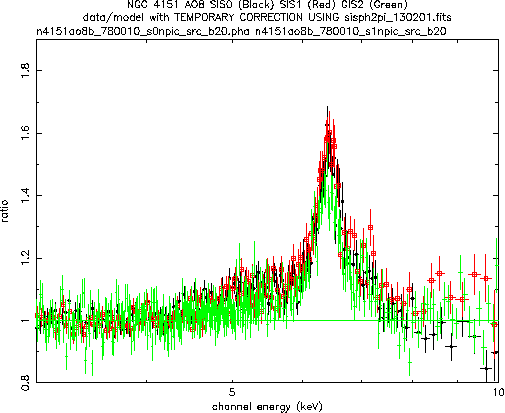Non-linear Secular Evolution of the SIS CTI
Originally posted on January 5th, 2001.
We have discovered a significant problem in the gain calibration of recent SIS data, particularly for SIS-1 data taken during AO-8 (calendar 2000). It appears that the Charge Transfer Inefficiency (CTI) is evolving non-linearly with time, whereas we currently use linear extrapolations from the last determination of CTI values on 1997 March 11.
We posted this preliminary report on January 5th, 2001,
to warn of this problem. The SIS team has now released a
![]() temporary
patch, but continues to refine the energy scale calibration.
temporary
patch, but continues to refine the energy scale calibration.
Symptoms

The profiles of Fe K alpha line of NGC 4151 during the 2000 May observation, obtained using the current set of calibrations.
The problem was first noticed in the long observation of NGC 4151 performed in 2000 May. The Fe K-alpha line profiles measured with SIS-0 and SIS-1, using the current calibrations, disagree with each other at a highly significant level.
Re-examination of Cas A calibration observations performed in 1999 summer suggests that the SIS-1 gain was lower than the SIS-0 gain by 1-1.5%. During 2000, the gain difference may have increased to about 3%. It appears that SIS-0 gain has increased relative to current calibration, while that of SIS-1 has decreased.
Such gain miscalibrations can lead to incorrect and mutually inconsistent line profiles in bright sources; they can also affect the determination of continuum shapes in moderately bright sources. The latter is particularly important where the effective area is a steep function of energy, and hence can lead to incorrect values of Nh. [However, other aspects of radiation damage probably also contribute to the low energy calibration problem; see the empirical characterisation of the combined effect.]
Non-linear evolution of CTI

A plot of long-term history of the Ni line energy, measured without CTI correction (but with DFE and echo corrections).
The figure above shows the evolution of CTI, as indicated by the background Ni line (from all available 1-CCD Faint mode data without a bright source). Because the Ni line is produced both in the exposure region and the frame-store region of the CCDs, it is not directly usable to calibrate the CTI for the celestial X-ray photons. However, it is a good relative indicator of the CTI.
As seen in the figure, Ni line energies of both SIS-0 and SIS-1 decreased almost linearly up to 1997. Since then, however, the rate of decrease increased in SIS-1, which seems to have reached a saturation point in 1999. In the case of SIS-0, the rate of decrease was almost constant up to 1999, but may have slowed down somewhat since then. These results clearly show that current assumption of linear increase of CTI with time is incorrect.
Some deviation from the linear trend was already seen in the 1999 calibration observations of Cas A; however, the interpretation was made difficult by the slight pointing offset during these observations (a quarter to a third of Cas A was not imaged on the SIS-1 default chip). With hindsight, however, these data do confirm the non-linear evolution of CTI for both SIS-0 and SIS-1.
The SIS team has produced an updated CTI calibration file,
sisph2pi_290301.fits.
This file can be applied to any SIS event files prior to spectral extraction,
using the FTOOL sispi. The use of this file results in a marked
improvement in the Fe K alpha line profile of NGC 4151 as seen above.
We have tested this file with a variety of data, and confirmed that
it does not degrade SIS spectra from earlier epochs or at lower energies.
Usage of the new CTI file:
WARNING: The SIS team is aware that an energy scale
problem still remains using this CTI file, although at a much reduced
level (the energy of the narrow core of the Fe line in the NGC 4151
data above are about 20 eV off in SIS data re-calibrated with this
new calibration file, with respect to GIS-2).
The remaining problem is noticeable only in very high signal-to-noise
data. This should be considered a temporary patch.
It now appears likely that the current CTI formula, in which
charge loss is assumed to be proportional to the total charge
in a pixel, is incorrect. The SIS team is actively investigating
an appropriate functional form for the energy dependence, and
hope to release a further improved CTI calibration file
(and updated software that can utilize it) within the next few months.
![]() Temporary patch: a new CTI file
Temporary patch: a new CTI file
The profiles of Fe K alpha line of NGC 4151 during the 2000 May observation
(black: SIS-0; red: SIS-1, both processed with
sisph2pi_130201.fits; green: GIS-2).
Note this file has been updated on March 29
to correct a separate problem.
The earlier version (sisph2pi_130201.fits) has the identical
CTI calibration table as this newest version.
Future works
If you have any questions concerning ASCA, visit
our Feedback form.

